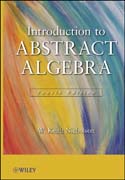
This Fourth Edition of Introduction to Abstract Algebra is a self-contained introduction to the basic structures of abstract algebra: groups, rings, and fields. This book is intended for a one or two semester abstract algebra course. The writing style is appealing to students, and great effort has been made to motivate and be very clear about how the topics and applications relate to one another. Over 500 solved examples are included to aid reader comprehension as well as to demonstrate how results in the theory are obtained. Many applications (particularly to coding theory, cryptography, and to combinatorics) are provided to illustrate how the abstract structures relate to real-world problems. In addition, historical notes and biographies of mathematicians put the subject into perspective. Abstract thinking is difficult when first encountered and this is addressed in this book by presenting concrete examples (induction, number theory, integers modulo n, permutations) before the abstract structures are defined. With this approach, readers can complete computations immediately using concepts that will be seen again later in the abstract setting. Special topics such as symmetric polynomials, nilpotent groups, and finite dimensional algebras are also discussed. INDICE: Preface ix Notations Used in the Text xix A Sketch of the History of Algebra to 1929 xxii 0. Preliminaries 1 1 0.1 Proofs 1 0.2 Sets 5 0.3 Mappings 9 0.4 Equivalences 17 1. Integers and Permutations 23 1.1 Induction 23 1.2Divisors and Prime Factorization 31 1.3 Integers modulo n 42 1.4 Permutations53 1.5 An Application of Cryptography 65 2. Groups 67 2.1 Binary Operations 67 2.2 Groups 74 2.3 Subgroups 83 2.4 Cyclic Groups and the Order of an Element88 2.5 Homomorphisms and Isomorphisms 97 2.6 Gosets and Lagranges Theorem 1072.7 Groups of Motions and Symmetries 116 2.8 Normal Subgroups 120 2.9 Factor Groups 129 2.10 The Isomorphism Theorem 135 2.11 An Application to Binary Linear Codes 141 3. Rings 157 3.1 Examples and Basic Properties 157 3.2 Integral Domains and Fields 168 3.3 Ideals and Factor Rings 177 3.4 Homomorphisms 186 3.5 Ordered Integral Domains 196 4. Polynomials 199 4.1 Polynomials 199 4.2 Factorization of Polynomials over a Field 211 4.3 Factor Rings of Polynomials overa Field 224 4.4 Partial Fractions 233 4.5 Symmetric Polynomials 246 4.6 Formal Construction of Polynomials 246 5. Factorization in Integral Domains 249 5.1Irreducibles and Unique Factorization 250 5.2 Principal Ideal Domains 262 6. Field 273 6.1 Vector Spaces 274 6.2 Algebraic Extensions 282 6.3 Splitting Fields 290 6.4 Finite Fields 297 6.5 Geometric Constructions 303 6.6 The Fundamental Theorem of Algebra 308 6.7 An Application to Cyclic and BCH Codes 310 7. Modules over Principal Ideal Domains 323 7.1 Modules 323 7.2 Modules over a PID334 8. p-Groups and the Sylow Theorems 349 8.1 Factors and Products 349 8.2 Cauchys Theorem and p-Groups 357 8.3 Group Actions 364 8.4 The Sylow Theorems 372 8.5 Semidirect Products 379 8.6 An Application to Combinatorics 383 9. Series of Subgroups 389 9.1 The Jordan-Hölder Theorem 390 9.2 Solvable Groups 395 9.3 Nilpotent Groups 402 10. Galois Theory 413 10.1 Galois Groups and Separability 414 10.2 The Main Theorem of Galois Theory 423 10.3 Insolvability of Polynomials 435 10.4 Cyclotomic Polynomials and Wedderburns Theorem 443 11. Finiteness Conditions for Rings and Modules 449 11.1 Wedderburns Theorem 449 11.2 The Wedderburn-Artin Theorem 459 Appendices App. A Complex Numbers 473 App. B Matrix Algebra 480 App. C Zorns Lemma 488 App. D Proof of the Recursion Theorem 492 Bibliography 595 Selected Answers 597 Index 499
- ISBN: 978-1-118-13535-8
- Editorial: John Wiley & Sons
- Encuadernacion: Rústica
- Páginas: 560
- Fecha Publicación: 24/02/2012
- Nº Volúmenes: 1
- Idioma: Inglés
- Inicio /
- MATEMÁTICAS /
- ÁLGEBRA
